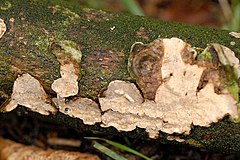Phanerochaete
| Phanerochaete | |
|---|---|
 |
|
| Phanerochaete velutina | |
| Scientific classification | |
| Kingdom: | Fungi |
| Division: | Basidiomycota |
| Class: | Agaricomycetes |
| Order: | Polyporales |
| Family: | Phanerochaetaceae |
| Genus: |
Phanerochaete P.Karst (1889) |
| Type species | |
|
Phanerochaete alnea (Fr.) P.Karst. (1889) |
|
| Synonyms | |
|
|
Phanerochaete is a genus of crust fungi in the family Phanerochaetaceae.
The genus was circumscribed by Finnish mycologist Petter Karsten in 1889.Marinus Anton Donk redefined the limits of the genus in two publications in 1957 and 1962.Phanerochaete has traditionally been delimited based on the overall morphology of the fruit body, as well as microscopic characteristics including the nature of the hyphal structure, cystidia, and spores. Molecular analysis published in 2010 demonstrates that the genus is polyphyletic, containing members placed throughout the phlebioid clade of the Polyporales.
The genus name is derived from the Greek words φανεφός ("distinct") and χαίτη ("hair").
Phanerochaete includes white rot fungi that are able to degrade the woody polymer lignin to carbon dioxide. This is achieved, in part, by lignin peroxidases and manganese peroxidases. These peroxidases are also able to mediate oxidation of a wide variety of organic pollutants. The genome of Phanerochaete chrysosporium was sequenced and shows the genetic potential to make over 100 . White rot fungi have been used in bioremediation efforts to break down potentially harmful chemicals in soil and in water. For example, phenol-formaldehyde is degraded by P. chrysosporium, while P. sordida breaks down the neonicotinoid pesticide clothianidin.
...
Wikipedia
